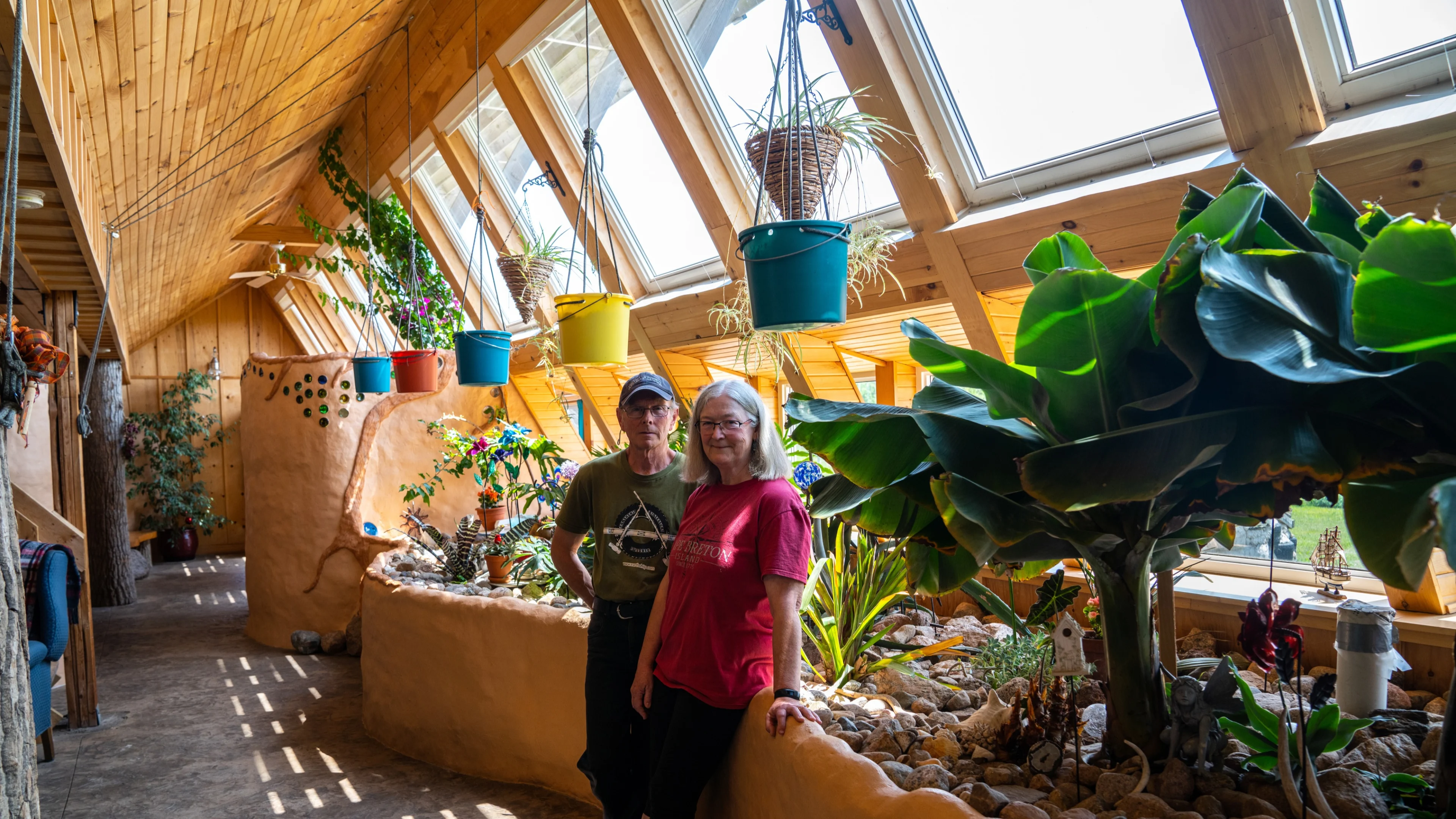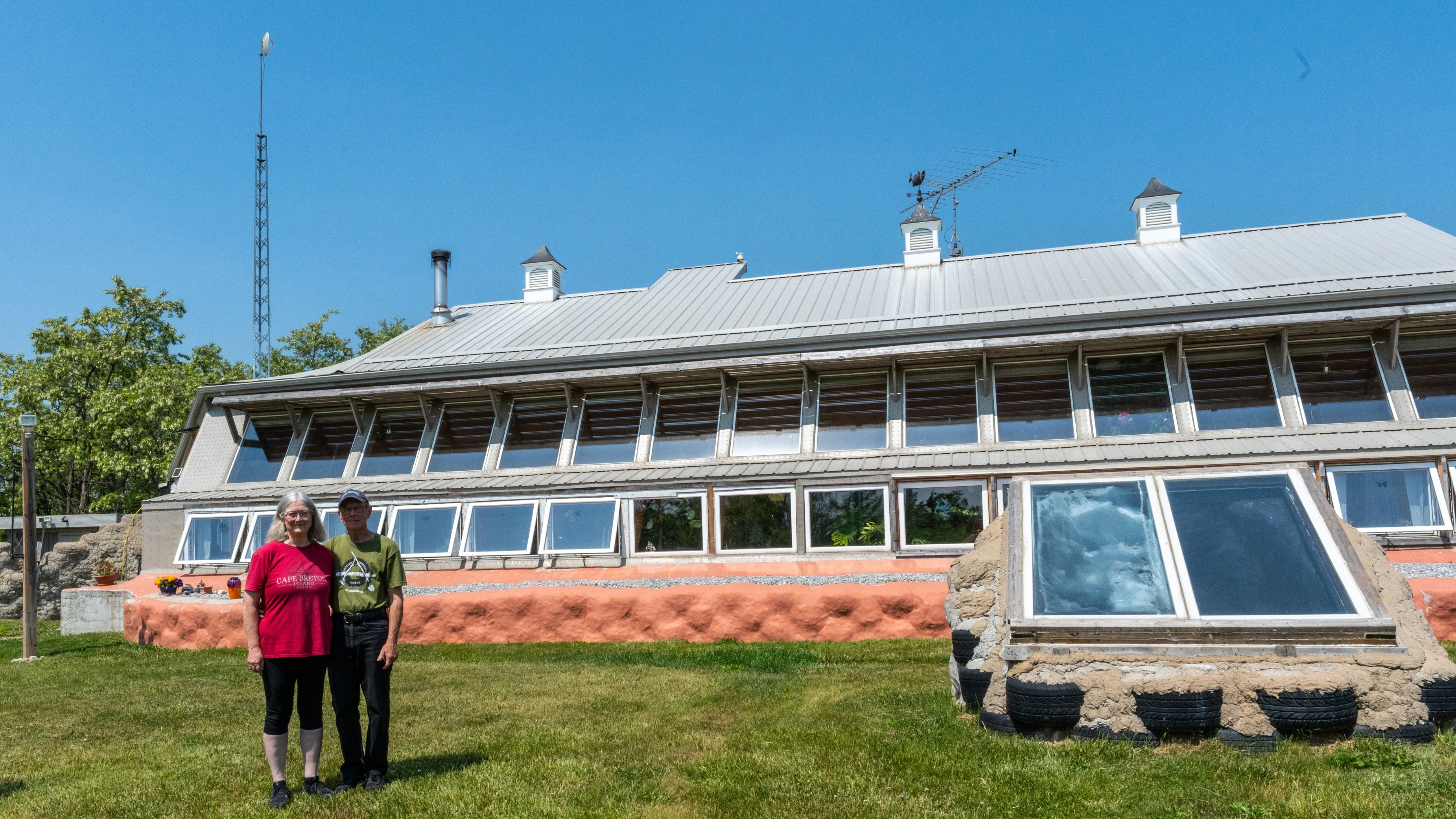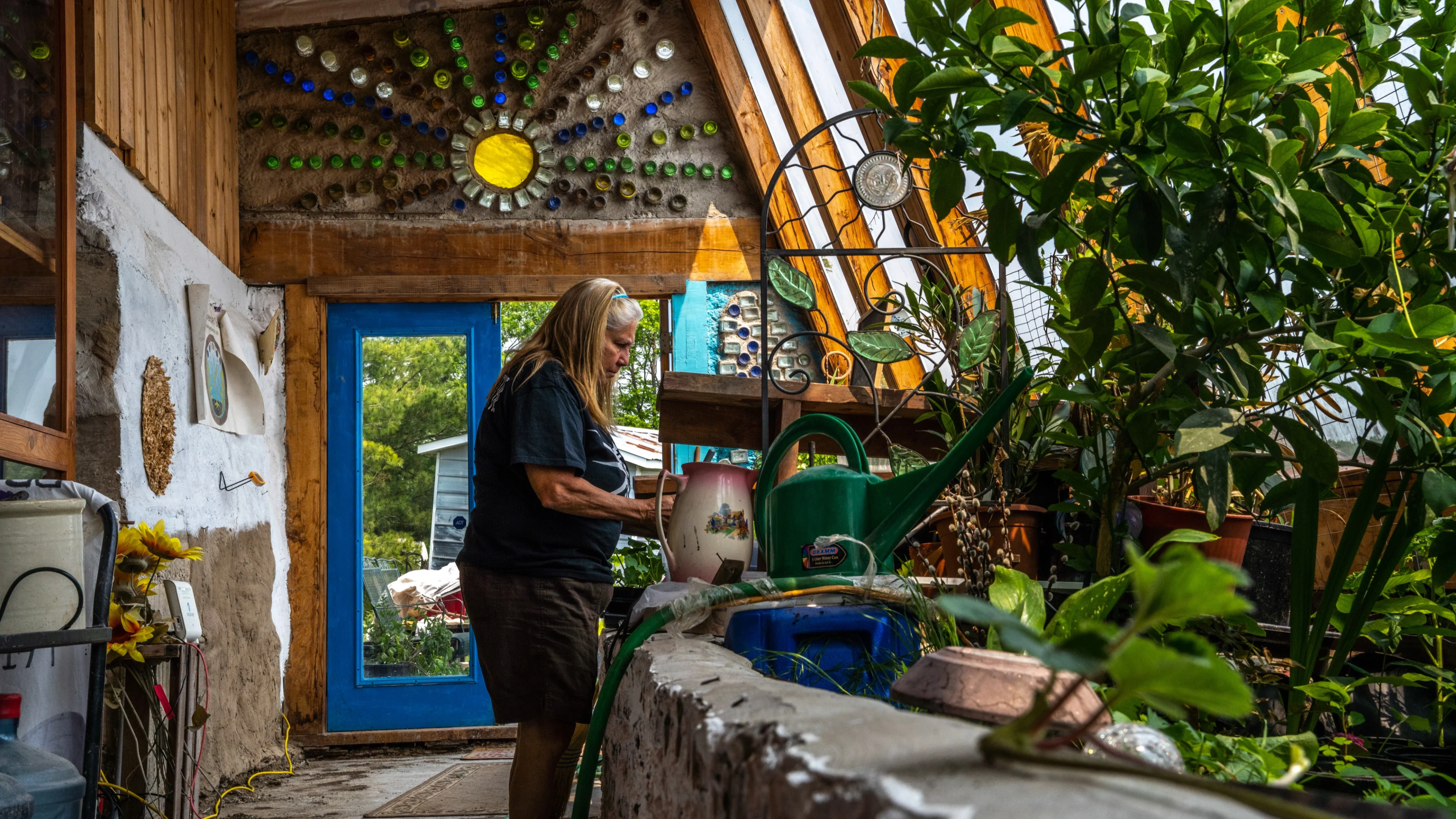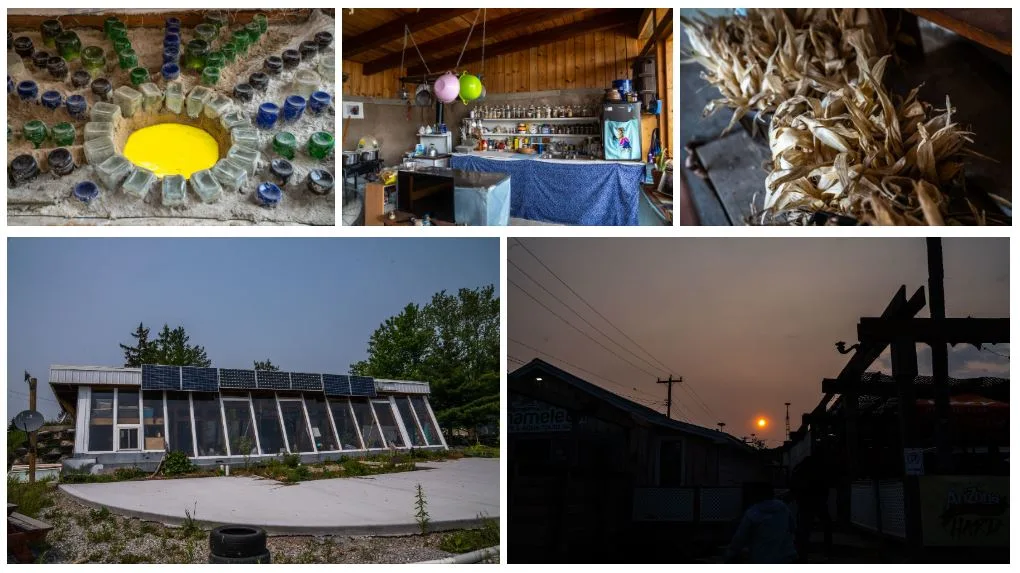
Living in an Earthship, this Ontario couple inspired others to build their own
Earth Overshoot Day is an annual date that marks when humanity’s demand for ecological resources and services in a given year exceeds what Earth can regenerate in that year. This year it’s on Aug. 2, according to the latest National Footprint and Biocapacity Accounts.
One group fighting against the overconsumption of resources is those who have chosen to live in unconventional Earthship homes.
What is an Earthship?
Despite what cosmic imagery the name may evoke, an Earthship is an architectural style of off-grid homes developed in the late 20th century by Michael Reynolds, designed to behave as passive solar earth shelters made of both natural and upcycled materials, such as earth-packed tires and colourful glass bottles encased in concrete. (Passive solar means that the building is designed to absorb heat from the sun's rays shining through the windows and store it.)
According to Reynolds, every Earthship addresses six basic needs:
Heating and cooling
Solar and electricity
Water harvesting
Contained sewage treatment
Building with natural and recycled materials
Food production
Without addressing all six of these areas, Reynolds maintains the structure would not be “thoroughly autonomous,” but rather would be another format of off-the-grid living that might incorporate solar panels and heating separately.
Follow The Weather Network's climate coverage on Instagram here
“It is more than housing. It's a machine,” Reynolds told The Weather Network. “The public does need eye-opening and an awareness to … walk away from the dogma of housing as it is today.”
According to the International Energy Agency (IEA), 30 per cent of global energy use can be attributed to heating and cooling structures. With a spike in interest for self-reliance and sustainable choices following the pandemic and rising inflation, Earthships could be a response to growing energy prices, housing affordability, and supply chain instability.
In Canada, a country with cold winters and a population dispersed across vast landscapes, the adoption of this architectural style has been met with skepticism and reluctance. However, those who have chosen to build and live in the structures have been enthusiastic about their potential.

Craig and Connie Cook outside their Earthship home on June 6, 2023. (Katherine Cheng/The Weather Network)
'The best house on the planet'
Craig and Connie Cook, a retired couple in Port Rowan, Ont., built their Earthship back in 2014 from materials estimated to have cost around $90,000. After having lived in the Earthship for nearly a decade, the couple continues to describe their home as “the best house on the planet.”
Previously living in a conventional house, the couple was seeking a quiet lifestyle in a sustainable house that was physically distant from others in anticipation of their retirement. Initially researching straw-bale houses, they ultimately discovered the concept of Earthships and decided to buy a plot of land and build the latter instead. However, their decision to do so has been met with its fair share of resistance.
“We literally had people say, ‘Why can't you build something normal?’” Craig told The Weather Network, recalling the early days of when they first started their construction. “Because normal doesn't work. They don't want to admit that normal doesn't work.”

(Clockwise from top left): Craig and Connie making coffee with milk, one of the few things that they purchase from the store. Craig stands inside of their new Earthship greenhouse, a separate structure that they plan to extend further into the back. Craig stands in front of a panel of solar panels. A windmill owned by a private company can be seen from the windows of the greenhouse, which pays the couple a monthly rental fee and some energy produced from wind in exchange for leasing their land to the company. (Katherine Cheng/The Weather Network)
To Craig, their Earthship is more than a home — being off-grid and self-contained represents freedom. Since the Earthship is disconnected from the hydro and electricity grids of traditional housing, the couple does not pay any bills except for the internet, phone, and small amounts of groceries.
Instead, they rely on energy sources such as solar, wind, and rain. Estimating they use approximately one kilowatt of electricity and six gallons of water each day between the two of them, the numbers are a fraction of the national average of 329 gallons typically used by Canadians per day.
For heating and cooling, the structure remains within a two-degree swing of 20 C throughout both summer and winter without the help of air conditioning or a furnace, using the power of air flow and thermal mass to control the temperature naturally.
“As far as climate change, I mean, this is the perfect house to live in,” Craig said.
To further expand on their independence, they’ve also been building a greenhouse over the past six months to grow produce, which has drawn a lot of attention from others as an attainable goal — especially in the face of inflation, energy instability, and climate change.
Watch below: Residents generate own power in off-grid island community
“[We] researched this for a long time before we started building. And that's what you need to do. You need to really know that this is the house for you,” Connie said, cautioning against curious enthusiasts who may not be familiar with this concept.
“They all have to be tweaked for where you live. And that's basically what we've done here,” Connie added, making reference to the New Mexico roots of the Earthship architectural style.
Craig pointed to modifications such as the size and number of the south-facing windows to regulate the wide fluctuations of Canadian seasons.
When they first built the Earthship, they had little mentorship on how to model their house within the local context, counting approximately five Earthships in Ontario. Now, they estimate there are approximately at least 20. Since they’ve built their home, they also regularly help friends with building their own homes and believe they have hosted over 5,000 visitors interested about this way of living.
Earthships and Indigenous knowledge
One of these visitors was Terrylynn “Será:sera” Brant, founder of Mohawk Seedkeepers, who decided to start her own Earthship four summers ago to house her garden after helping a friend build an Earthship.

Terrylynn Brant tends to her plants in her Earthship garden on June 5, 2023. (Katherine Cheng/The Weather Network)
Dedicated to traditional Haudenosaunee ways of farming and passing on those ways to young farmers in the community, Brant built her own Earthship garden with the help of 40 volunteers over the course of one month after checking out the Cooks’ home.
Providing a location for Brant’s workshops, the space is used for teaching the younger generation skills such as how to take care of strawberry plants and inspiring others to build an Earthship of their own on Six Nations.
With a focus on farming, all the water in Brant’s Earthship is used six times. Rainwater that’s collected will be filtered by charcoal to an underground river and through a peat moss system to water the plants, with the leftover water then making its way to an aquaponic with fish. The fish fertilize the water and a small solar pump carries the nutritious water back to the plants, where the remaining water either goes through the same cycle again or gets carried over to the bathroom for the toilet.

(Clockwise from top left): Glass bottles arranged to represent the story of creation welcomes visitors atop the front door of the Earthship garden. A kitchen holds the seeds and spices collected by Brant. Corn husks sit atop a hidden floor compartment that hides the underground water system that runs from the rainwater tank to her garden. Smoke from wildfires turns the sun bright orange an hour away from Six Nations. The exterior of Brant’s Earthship. (Katherine Cheng/The Weather Network)
“[It’s] not about an Earthship itself, it’s about developing a sustainable structure — all structures – that use the resources from the land as much as possible,” Brant said. “They need to solve problems, not create them.”
With the first-ever Earthship built in 1979, the close-knit community has now grown to an estimate of approximately 3,000 Earthships worldwide. In Canada, over 200,000 off-the-grid homes exist already, mostly concentrated in northern communities.
As Canada looks to address its housing crisis amid a rapidly changing climate, Brant and the others believe that the ancient homes from the past can provide a roadmap for the future of housing to look towards.
Thumbnail image: Craig and Connie Cook in their Earthship home on June 6, 2023. (Katherine Cheng/The Weather Network)











